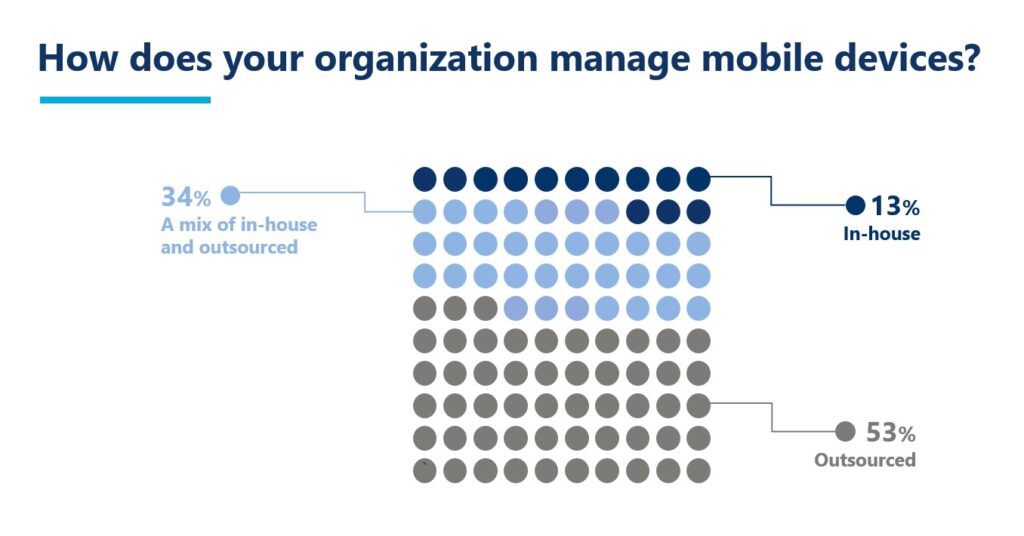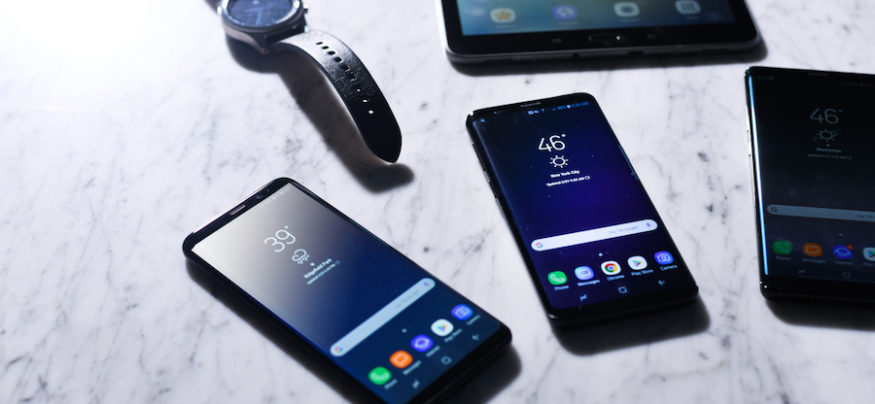Whether you’re planning a corporate-issued mobile deployment or launching a Bring Your Own Device (BYOD) program, it’s critical to ensure you have the headcount in place to manage both the initial rollout and the ongoing IT support and administrative tasks. The question is: how much time will it take to manage a mobile device program, and how many full-time IT staff will you need to retain?
According to the recent Maximizing Mobile Value study, conducted by Oxford Economics, the average organization issuing smartphones to 250 employees will require just over one full-time equivalent staff to manage the program. The study estimated that this represents an annual investment of around $114,500, inclusive of salary and overheads. For a detailed, personalized analysis of the total costs involved in a mobile deployment, use our Mobile Cost Calculator.
What is the IT staff to end-user ratio?
The number of IT staff required to oversee a mobile phone or tablet deployment has a strong correlation to the number of end-users and devices that need to be managed. However, larger enterprises can achieve some significant economies of scale since many mobile device management tasks are automated, staff members can become more specialized and efficient processes can be put into place. To quantify that, the study found that a smaller business with 250 employees would have an IT staff to end-user ratio of about 1:220, while a large enterprise with 10,000 employees across multiple locations could expect to have an IT staff to end-user ratio of 1:600 (equating to an IT support team of 16-17 full-time equivalent staff).
What do Mobile Device Managers do?
Mobile device managers handle a variety of tasks throughout the lifecycle of a mobile deployment, including:
- Kitting and shipping new and replacement devices to employees
- Enrolling devices into a Mobile Device Management (MDM) program
- Creating and updating device profiles or configurations within the MDM
- Supporting access to mobile email and other applications
- Supporting users in locating or wiping lost or stolen devices
- Establishing mobile security policies, conducting security checks and educating end-users on security risks
- Managing device repairs
- Managing mobile stipends (this is often handled within HR or payroll)
Outsourcing to managed mobility service providers
IT headcount can be reduced significantly if an organization enlists the help of a third-party service provider to support its mobile program. Mid-sized organizations opting for a Mobility-as-a-Service (MaaS) model — where smartphones are leased from and fully managed by the service provider — may only require a single program administrator to negotiate MaaS contract renewals and handle in-house oversight duties.
 Outsourcing mobile device management has become increasingly popular over the past decade. The Maximizing Mobile Value study found that 53 percent of businesses have fully outsourced their mobile management, with another 34 percent outsourcing some tasks while handling others in-house. Only 13 percent of businesses handle all aspects of mobile management internally.
Outsourcing mobile device management has become increasingly popular over the past decade. The Maximizing Mobile Value study found that 53 percent of businesses have fully outsourced their mobile management, with another 34 percent outsourcing some tasks while handling others in-house. Only 13 percent of businesses handle all aspects of mobile management internally.
Plan a Successful CYOD Program
Download our comprehensive 8-step guide to planning and deploying a CYOD initiative at your company. Download Now
When considering the IT staffing and costs for a new mobile program, it’s important to look at in-house overheads and third-party service provider fees in tandem. According to the Maximizing Mobile Value study, smaller businesses can likely achieve significant savings by having a managed services provider run their program, while larger enterprises may have the scale, resources and expertise to manage and deploy devices efficiently on their own.
BYOD or corporate-issued?
Just because an organization is not issuing smartphones to its workforce doesn’t mean that significant IT resources won’t be required for mobile management. Companies adopting a BYOD approach often still require their employees to install enterprise mobility management (EMM) clients on their personal devices and implement basic EMM policies. BYOD organizations also still require a mobile support desk to help employees with access to corporate email and applications. Additionally, the vast majority of BYOD organizations provide mobile stipends to employees, and this requires administrative oversight from payroll.
According to the Oxford Economics study, which drew on interviews with 500 senior IT and business leaders, organizations operating BYOD policies should anticipate requiring roughly 25 percent fewer full time equivalents than for a corporate-issued mobile program. The study estimated the average annual investment for salary and overheads for a 250-device deployment to be around $86,250 for an organization operating a BYOD program, compared to the $114,500 cited above for the corporate-issued mobile program.
Regulated industries have greater management overheads
Organizations operating in highly regulated environments such as government, healthcare and finance should also anticipate increased staffing and expenditure for the administration of mobile device programs. According to the Maximizing Mobile Value model, the 250-employee corporate-issued device deployment would represent an investment of $132,000 in annual salaries and overheads in a regulated-industry context.
This is due to more stringent mobile security and management infrastructure requirements. For example, regulated organizations will typically have in place more advanced EMM solutions, including application blocklisting, containerization and two-factor authentication. IT teams will be larger, more complex and, in some cases, more highly compensated.
Creating a staffing model is a key part of planning any mobile program. Get our comprehensive guide to planning a successful mobile deployment.






